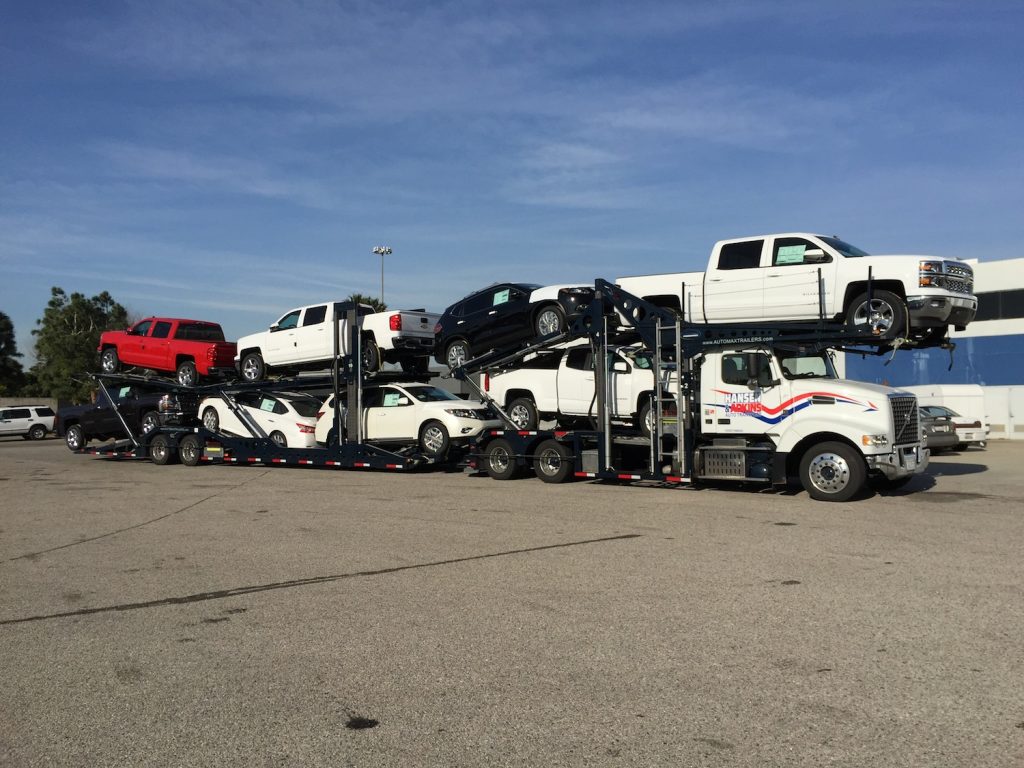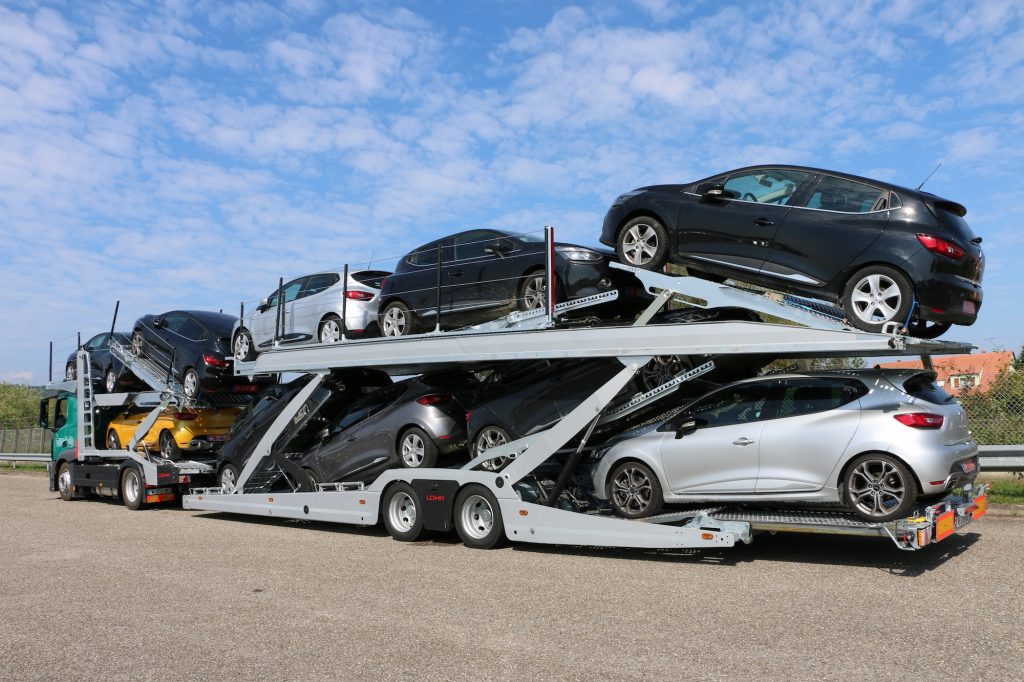 Transporter manufacturers face rising demand and complexity, with a need to balance regulations with load factors and growing concerns over driver ergonomics
Transporter manufacturers face rising demand and complexity, with a need to balance regulations with load factors and growing concerns over driver ergonomics
Growth in vehicle production in many markets has increased demand for car-haul equipment. But while there is demand for trailer manufacturers to produce more equipment, the sector must also balance other factors, including the need for greater loads and increased safety and comfort for drivers. Equipment manufacturers across the world are adapting to these changing requirements, while also working on ways to improve fuel mileage and make equipment more flexible in handling different vehicle sizes and cargo types.
In this story...
Such design improvements, however, are often set against uncertain legislation around truck and car transporter dimensions. In China and India, for example, central governments are in the process of establishing new standards that aim to end chronic overloading.
Put simply, regulation doesn’t always match up to the industry’s needs, and there is an on-going battle in the transporter industry to better align laws. In the US, carriers are lobbying to increase weight limits and extend overhang. “With strict USDOT [US Department of Transportation] requirements regarding weight, and the car manufacturers building bigger and heavier vehicles, load capacity has been, and will be, limited unless the DOT loosens up the weight limits,” says William Billiter, managing partner and owner of Metrogistics.
Alex Meza, chief commercial officer at Jack Cooper Holdings, says the company – the largest carrier in North America – has been pushing for a 10% increase in the loaded weight limit to 88,000 pounds (39,600kg) and a 5ft increase in the trailer length to 80ft (24.4 metres). Meza says the campaign to change these dimensions has gained momentum in the past year.
“This would allow us to increase our load factor by one unit, on average. As an industry, that would permit car-hauling capacity to increase by an estimated 15%,” he says.
Following years of consolidation and liquidations, the US is today left with one main manufacturer of new car transporters: Cottrell, based in Gainesville, Georgia. Although the company declines to comment or grant interviews, carrier customers say it is producing to full capacity, with four months of backorders.
Billiter says that Metrogistics recently ordered 12 new trucks, which will take 5-6 months to receive. “The burn-off rate is much higher now than the speed at which Cottrell can build. Supply – as it currently exists – will be unable to catch up,” Billiter says. He anticipates the supply of assets will continue to be an issue through to 2018.
However, production lead time is an issue for some carriers more than others. Meza points to considerable idled capacity at Jack Cooper following its acquisition of Allied Automotive Group in 2013.

“There is a lot of caution, and some carriers view it the same way,” Lugo says. “Several other companies are building car transporters but they do not have the traction to attract the same carriers.”
Lugo Manufacturing’s new equipment is aimed at addressing a weight bias towards the steer axle in trucks today, as equipment in the US has increased in weight by 1,500 pounds following fuel efficiency requirements. “Using a cab and chassis from Volvo and Peterbilt, respectively, we have designed a transporter with a wheelbase that is significantly different from Cottrell’s, in which the steer axle is much lighter,” says Lugo. “The empty weight is comparable to Cottrell’s, but the wheelbase is shorter and the placement of the drive axle group on the fifth wheel is different. This helps to avoid exceeding weight limits on axles.”
Bill Pawluk, chief executive officer of CTM Worldwide is pushing the industry to use convertible trailers that could carry both vehicles and general freight. CTM is developing a 53ft hi-mount convertible trailer for the US market that will be completed later this year. The company’s stinger convertible trailer system is not yet legal in the country to carry general freight on the tractor portion, but it can transport freight on the trailer. Meanwhile, CTM has also developed its first model for the western European market and is launching a pilot programme in the autumn.
There are other small players looking to serve niches in the growing North American market. Ernest Dandridge Carrier Design Services, now based in McLean, Virginia, converts trailers to carry vehicles outside the standard car transporter design. According to founder Ernest Dandridge, its modules can be used in Kentucky drop frame, electronic van trailers for stacking and transporting trailer loads of vehicles. The modules can be slid in and out of a trailer. “This hauling equipment can be used for fleets, owner operators, or car dealer chains,” he says. “The car trailer vans can be coupled to almost any common Class 8 freight tractor.”
Getting it right for drivers in Europe

However, European manufacturers continue to invest in more efficient designs and technology. Over the past few years, for example, Italy-based Rolfo has offered a zinc/nickel-coated corrosion-free body and trailer. “Our improvements have enabled higher load factors, as well as vehicles of greater dimensions and weights,” says sales director Alberto Picco.
Rolfo introduced a self-bearing frame for all its products 18 months ago, which holds more volume, reduces fuel consumption, and reduces trailer weight by 20-30%. Over the past year, Rolfo has also introduced a product for the British market that holds up to 11 vehicles compared to the previous ten, as well as a new trailer for transporting high-and-heavy equipment that holds up to three mega-cab trucks, instead of the previous two.
Zbigniew Roman, director, technical department at Poland-based carrier Adampol, says it has adapted its cab by lowering the roof so it can connect to the trailer’s top platform, increasing the load factor by one unit. However, he feels that transporter manufacturers have at times failed to meet customer demands for ergonomics. “Most equipment manufacturers do not focus on meeting the car carrier’s expectations. For example, the cabins are tight and poorly equipped from the driver’s perspective,” he says. “There is a lack of storage space for the driver’s personal items needed on the road. This is due to the low positioning of the cabin and its small height,” Roman says.
However, with the shortage of drivers becoming critical, manufacturers are responding with more ergonomic design features. Rolfo has introduced a new hydraulic system for easier and safer operation for drivers, for example.
Eric Belton, managing director for Lohr Industrie, says driver awareness and ease of use is critical to improving trucking operations. “The driver is 99% of the key element to deal with the problem of optimising the load factor,” he says. “If the driver were unfamiliar with a particular combination of vehicles, it would take more time to load them. We are working on information technology that will instruct the driver on how to load a specific combination of cars in order to maximise the load factor.”
Lohr is also working on maintenance notification signals that will reduce equipment downtime.
Gunther Percht, managing director, Kässbohrer Transport Technik, based in Austria, says the company has also improved its equipment’s useability for drivers. The position of the hydraulic control unit has been raised to an ergonomic level, for example.
Percht predicts that manufacturers will face further challenges as alternative fuel vehicles gain in popularity, including all-electric and fuel-cell cars and trucks that may vary considerably in size and shape.
India has faced problems in its road carrier industry, however some improvements have recently been made. The maximum transporter length is coalescing around 23 metres, and a design that accommodates different types of passenger vehicles, including SUVs, according to V. Anand, senior general manager for sales logistics at Hyundai Motor India.
However, despite moving towards a more common carrier size, the market still lacks legal clarification over lengths. Anand says that more than 98% of passenger vehicles in India move by road in rigid trucks 12-16 metres long, or trailers between 18.75-23 metres long. “The contentious issue of car carrier dimensions needs clear definition. This issue has been dragging on for more than five years,” he says. “Real additions to carrier fleets will happen only following a well-defined policy initiative from the central government that the states support.”

It’s not just the dimensions that cause problems in India; finished vehicles still move in fully covered trucks and trailers. “The fear of damage, theft, and pilferage is still holding back change to an open type of car carrier,” he says. “We need innovative designs to suit our terrain and the psychology of users, which therefore makes it difficult to adapt to the design of car carriers used in developed countries.”
One design feature that would improve Hyundai’s business, according to Anand, is a drawbar pull configuration for trailers to ensure a smaller turning circle. All the trailers in use are articulated, and the current turning circle exceeds the 25-metre upper limit suggested for road safety. “Additionally, the electrical system and the hydraulics for actuating the decks and rear door, which slides down as a ramp for loading and unloading, need major improvements,” explains Anand.
As the trucks have to use the vehicle’s battery as a power source for deck and door hydraulics without adequate insulation, there have been several major fire accidents that have damaged entire vehicle loads. The fuel tanks provided by trailer manufacturers are also inadequate, leading to transport operators adding tanks to carry more fuel. “In India, the price of diesel is different in each state based on local taxes and logistics costs. Most transport operators take advantage of lower costs of fuel in some states and they use these poorly designed tanks, thus compromising safety,” Anand says.
A more global outlook
Trailer manufacturing tends to be highly regional. Local requirements and regulations can make trailer export or shared designs across countries difficult. In North America, Cottrell and others are focused mainly on the US, Canada and now Mexico. At the other end of the world in Australia, manufacturers are similarly focused on local niches. Here, journeys range between 2,500-4,000km, sometimes through harsh, hot conditions. Transmech Australia, based in Adelaide, builds trailers around the variety of the market, offering some ten different designs for trailers that move anything between 2-11 vehicles. “To choose the right product, we must ask [hauliers] what type of vehicles will be used [on the equipment], and where will they operate within the country,” says Scott Hilditch, chief operating officer.
There are exceptions to this regionalisation. CTM, which has a global partnership with Lohr, has highly global ambitions, and is currently running trials or in discussion with carriers in India, China and Latin America.
"Real additions to carrier fleets [in India] will happen only following a well-defined policy initiative from the central government that the states support" – V. Anand, Hyundai Motor India
Europe’s trailermakers have also pushed their global expansion. Rolfo, already with plants in Italy, France and India, opened its newest earlier this year in Johannesburg, South Africa. “We are experiencing increased demand in South Africa and we determined that producing locally was more efficient than shipping there,” says Alberto Picco. Rolfo has also expanded in central Asia, north Africa, South Africa, Argentina, and India.
Lohr, which operates plants in France, China, Mexico, the US, Serbia, India, and Turkey, also opened a knockdown assembly shop in Durban, South Africa, says Eric Belton.
Regardless of whether companies push their products internationally, the car transporter manufacturing sector is an industry with increasingly global challenges and regulatory issues. No matter how different the local terrain, most manufacturers and carriers across the world agree on the basic needs to balance load factors with regulatory demands, improve driver safety, and reduce vehicle damage.

























![Global[1]](https://d3n5uof8vony13.cloudfront.net/Pictures/web/a/d/s/global1_726550.svgz)










